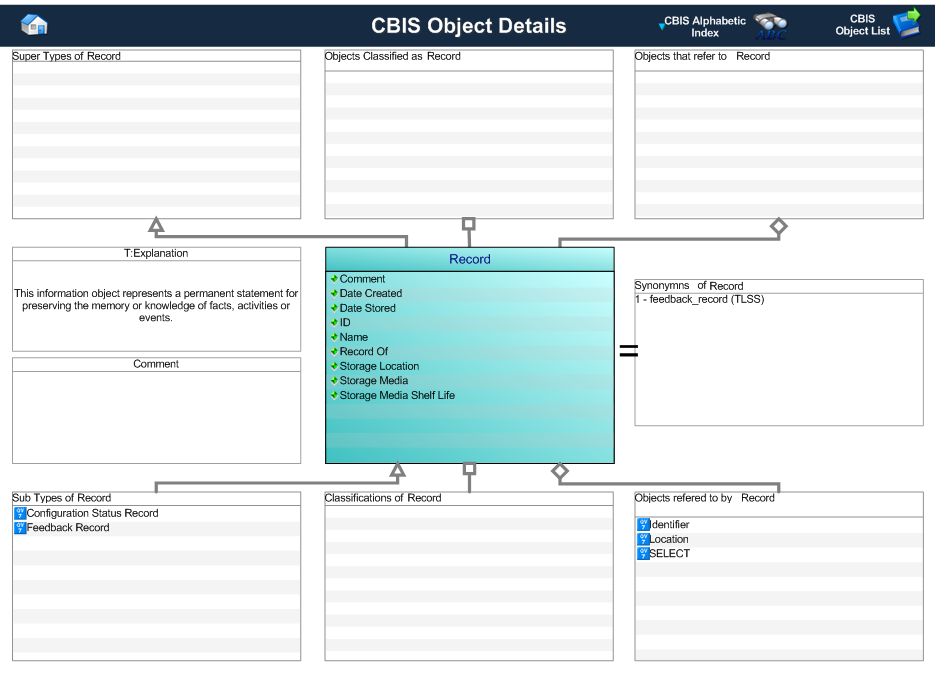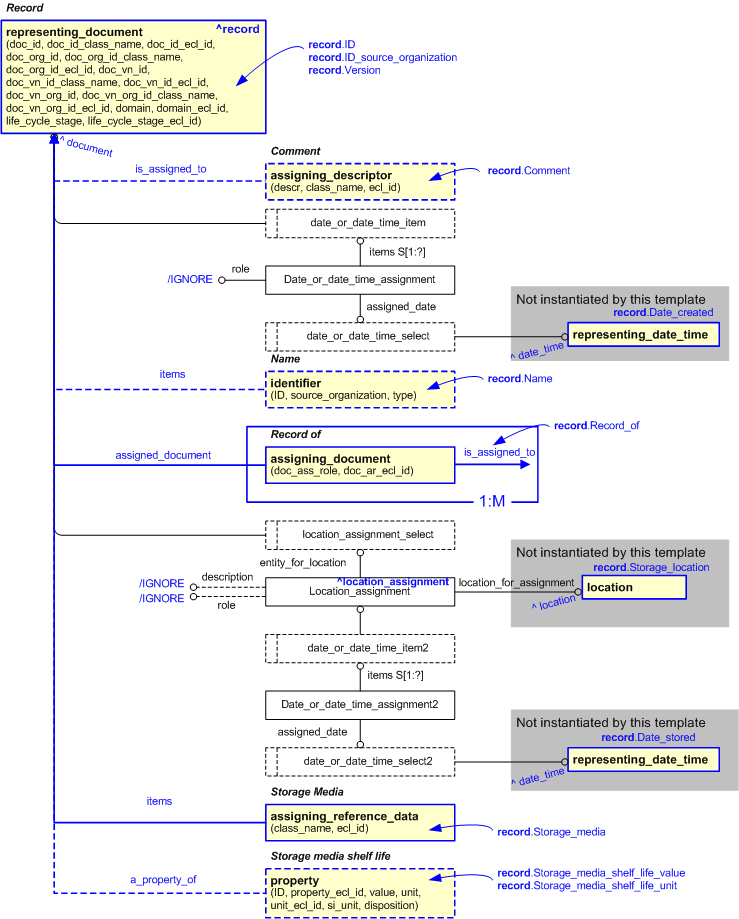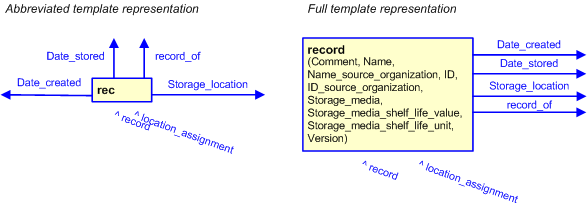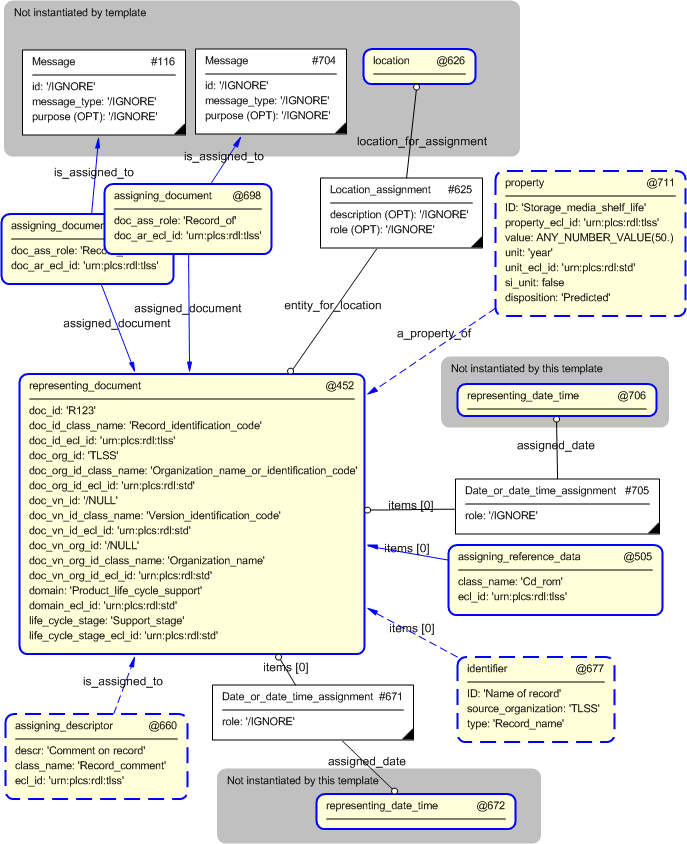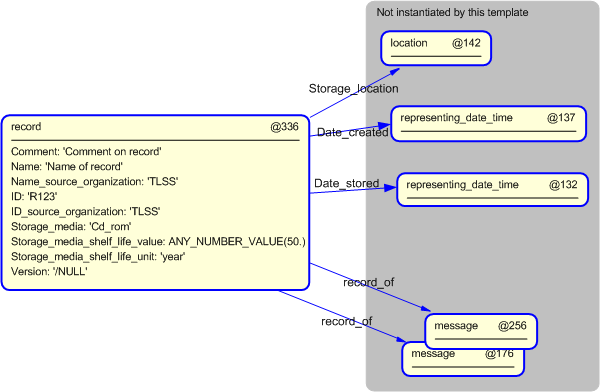Template:— record (rec)
Context:— UK_Defence |
Date: 2009/04/17 11:32:30
Revision: 1.3
|
This section specifies the template record.
NOTE
The template has been defined in the context of
UK_Defence.
Refer to the business context for details of related templates.
NOTE
An explanation of a template and the associated instantiation path is
provided in the
Template overview
section.
This template describes how to represent the UK_Defence concept of a record in terms of PLCS
model elements (templates, entities, and reference data).
This information object represents a permanent statement for preserving the memory or
knowledge of facts, activities or events.
Figure 1 — Graphical Representation for Business Object Record
Record:
The definition of a record object is: This information object represents a permanent
statement for preserving the memory or knowledge of facts, activities or events.
|
Attribute name
|
Attribute description
|
Attribute type
|
Optionality
|
| Comment |
This is a comment / description about / of the record. |
intrinsic |
Optional |
| Date Created |
This is the date on which the record was created. |
intrinsic |
Mandatory |
| Date Stored |
This is the date on which the record was stored. |
intrinsic |
Mandatory |
| ID |
This is the identifier of the record. |
Identifier |
Mandatory |
| Name |
This is the name of the record. |
intrinsic |
Optional |
| Record of |
This is the reference to the information object(s) for which the
record is made.
|
SELECT |
Mandatory (1:?) |
| Storage Location |
This is the reference to the location where the record is stored. |
location |
Mandatory |
| Storage Media |
This defines the type of information storage media on which the
record is stored.
EXAMPLE
"A0 paper", "A1 paper", "A2 paper", "A3 paper", "A4
paper", "70 minute CD", "80 minute CD", "DVD", "video",
"microfilm".
|
Intrinsic |
Mandatory |
| Storage Media Shelf Life |
This is the shelf life of the media on which the record is stored. |
Intrinsic |
Optional |
Table 1 — Record attribute details
The EXPRESS-G diagram in
Figure
2
shows the templates and EXPRESS entities that are required
to represent the template
"record".
The text highlighted in blue shows the template parameters.
Figure 2 — An EXPRESS-G representation of the Information model for record
The graphic for the template to be used in other EXPRESS-G diagrams
is shown in Figure
3
below.
Figure 3 — The graphical representation of the record template
The following input parameters are defined for this template:
A comment about the record. If this attribute is not required, the relevant
assigning_descriptor template should not be instantiated.
Record creation date-time.
Record storage date-time.
Name (Type='STRING', Optional)
The name of the record. If this attribute is not required, the relevant
UK_Defence.identifier template should not be instantiated.
The name of the organization responsible for identifying the record. If this attribute is not required, the relevant
UK_Defence.identifier template should not be instantiated.
The identifier of the record.
The identifier of the organization responsible for identifying the record.
The item to which the record is assigned.
The name of the class used to classify the
Document that
constitutes the record and thereby indicate the storage medium of that record.
The following classes and their sub-classes can be used:
The time interval over which the storage medium would normally expected to maintain the integrity of the stored data expressed
as a number of the time units represented in the parameter @Storage_media_shelf_life_unit.
If this attribuute is not required, the relevant
UK_Defence.property template should not be instantiated.
The time or duration units in which the time interval over which the storage medium would normally expected to maintain
the integrity of the stored data is expressed.
If this attribuute is not required, the relevant
UK_Defence.property template should not be instantiated.
The following classes and their sub-classes can be used:
The following reference parameters are defined for this template:
Allow the
Document
entity instantiated in this path to be referenced when this template is used.
Note: The
Document
entity can be referenced in a template path by:
%^target = $record.record%
where
target
is the parameter to which the
Document
is bound.
Allow the
Location_assignment
entity instantiated in this path to be referenced when this template is used.
%^target = $record.location_assignment%
The following parameter combinations specify a uniqueness constraint:
Unique constraint: Unique id
Each instance of the
entity
(
Document)
within the data set shall be uniquely identified
by a combination of the following parameters on this
template (record) namely:
ID,
ID_source_organization.
The
instance is
referenced by the following template parameter:
record.
The ID and ID_source_organization of the record should only occur once in
a data set.
The instantiation path shown below specifies the entities that are to be
instantiated by the template.
A description of templates and the syntax for the instantiation path is
provided in the
Templates Help/Information section.
-- record /
representing_document(
doc_id=@ID,
doc_id_class_name='Record_identification_code',
doc_id_ecl_id='urn:plcs:rdl:uk_defence',
doc_org_id=@ID_source_organization,
doc_org_id_class_name='Organization_identification_code',
doc_org_id_ecl_id='urn:plcs:rdl:std',
doc_vn_id='',
doc_vn_id_class_name='Document_version_identification_code',
doc_vn_id_ecl_id='urn:plcs:rdl:std',
doc_vn_org_id='/NULL',
doc_vn_org_id_class_name='Organization_identification_code',
doc_vn_org_id_ecl_id='urn:plcs:rdl:std',
domain='Through_life_support_standard',
domain_ecl_id='urn:plcs:rdl:uk_defence',
life_cycle_stage='Support_stage',
life_cycle_stage_ecl_id='urn:plcs:rdl:std')/
%^record = $representing_document.document%
-- [optional Comment] /
assigning_descriptor(
descr=@Comment,
class_name='Record_comment',
ecl_id='urn:plcs:rdl:uk_defence',
is_assigned_to=^record)/
-- Date created Date_or_date_time_assignmentDate_or_date_time_assignment.role = '/IGNORE'
Date_or_date_time_assignment.items ->
^record
Date_or_date_time_assignment.assigned_date ->
@Date_created-- [optional Name] /
identifier(
ID=@Name,
source_organization=@Name_source_organization,
type='Record_name',
items=^record)/
-- [1:M Record of] /
assigning_document(
doc_ass_role='Record_of',
doc_ar_ecl_id='urn:plcs:rdl:uk_defence',
is_assigned_to=^record,
assigned_document=@record_of)/
-- Storage location Location_assignmentLocation_assignment.entity_for_location ->
^record
Location_assignment.location_for_assignment ->
@Storage_locationLocation_assignment.description = '/IGNORE'
Location_assignment.role = '/IGNORE'
%^location_assignment =
Location_assignment%
-- Storage date Date_or_date_time_assignmentDate_or_date_time_assignment.role = '/IGNORE'
Date_or_date_time_assignment.items ->
^record
Date_or_date_time_assignment.assigned_date ->
@Date_stored-- Record of /
assigning_document(
doc_ass_role='Record_of',
doc_ar_ecl_id='urn:plcs:rdl:uk_defence',
is_assigned_to=^record,
assigned_document=@record_of)/
-- Storage media /
assigning_reference_data(
items=^record,
class_name=@Storage_media,
ecl_id='urn:plcs:rdl:uk_defence')/
-- [optional Storage media shelf life] /
property(
a_property_of=^record,
ID='Storage_media_shelf_life',
property_ecl_id='urn:plcs:rdl:uk_defence',
value=@Storage_media_shelf_life_value,
unit=@Storage_media_shelf_life_unit,
unit_ecl_id='urn:plcs:rdl:std',
si_unit='false',
disposition='Predicted')/
The following entities are instantiated with attributes as specified:
The instance diagram in Figure
4
shows an example of the EXPRESS entities and templates that are instantiated by the template:
/record(record_of='@176', record_of='@256', Date_created='@137', Date_stored='@132', Storage_location='@142', Comment='Comment on record', Name='Name of record', Name_source_organization='UK_Defence', ID='R123', ID_source_organization='UK_Defence', Storage_media='Cd_rom', Storage_location_shelf_life_value='50', Storage_location_shelf_life_unit='year', Version='/NULL')/
(an illustration of the consolidated record template is shown in
Figure
5 below.)
Figure 4 — Entities instantiated by record template
The instance diagram in
Figure
5
shows the graphic symbol for the template that is to be
used in other instance diagrams. The example template is:
/record(record_of='@176', record_of='@256', Date_created='@137', Date_stored='@132', Storage_location='@142', Comment='Comment on record', Name='Name of record', Name_source_organization='UK_Defence', ID='R123', ID_source_organization='UK_Defence', Storage_media='Cd_rom', Storage_location_shelf_life_value='50', Storage_location_shelf_life_unit='year', Version='/NULL')/
Figure 5 — Instantiation of record template
Characterizations
No common characterizations of the template
record
have been identified. However, the ISO 10303-239 EXPRESS model
may enable other assignments to the entities instantiated by the template.
